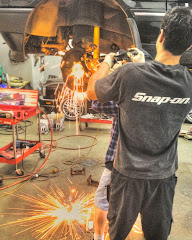 |
| Land Rover service. © copyright JE Robison |
My friend Bob called me to ask about his most recent car
repair experience. He said, Last week I noticed my brake fluid was low,
and the pedal went to the floor. I took
it to the shop, and they replaced a leaking caliper. Two weeks later, the same thing
happened. This time they say I need a
master cylinder? How come?
The experience of sequential repairs is all too common in
the automobile business. Sometimes it’s
due to technician error. But more often,
it’s the inevitable result of service policies or the step by step nature of
some repair operations. Let’s look at
some examples to see how it happens.
When Bob brought his car in for service the first time, he
had a visible problem. Brake fluid was
leaking at one of the wheels and it’s didn’t take much to see the source was a
failed caliper. Replacement was a
straightforward job and the garage sent the car on its way assuming it was
fixed for good.
Yet it failed again, just a few weeks later. This time the failure was not so
obvious. There were no leaks at any of
the wheels but the fluid was low. When
that happens there is only one place to look in most cars – the power brake
booster. Indeed, when the master cylinder
was pulled back from the booster the technician could see where fluid was leaking
and he ordered a new cylinder.
The question is, why did this happen two weeks after the
first repair?
The answer was clear with a little bit of thought. When everything is normal the guts of the
master cylinder don’t move more than a few thousandths of an inch to actuate
the brakes. When the system gets bled
following repair it moves through a much bigger range, half an inch or
more. If the seldom-used reaches of the master
cylinder have become roughened by corrosion the act of bleeding the brakes may
lead to the internal seals failing.
That’s what happened in Bob’s case. I asked myself how the repeat failure might
have been avoided. The first answer that
came to mind is more frequent brake fluid flushes. When the fluid is flushed the cylinders are
run through their full travel. Doing
that periodically would prevent buildup of corrosion and presumably prevent
failures like this. But at what cost? The more flushes would have cost more than
the cylinder, and required three service visits instead of the one repair.
Some would say the brakes could be bled through air
pressure, without moving the pedal.
That’s possible on some vehicles but the problem with that is that you
never see the system work through its whole range and that may blind you to
another more serious problem. So that
may work, or it may replace a harmless problem like this with a worse one.
In the end I concluded there is no way to assure a “one-step
fix” in a situation like this. Most of
the time, when the first job was done, the master cylinder would not fail. But every now and then, it will. When that happens you have a two-step repair.
Then there are the so-called emission problems – those
“check engine” lights that just won’t go away.
Many motorists believe that scan tools point us directly to failed
parts, but all too often that is not the case.
Fault codes are symptoms, many of which have numerous possible
causes. Sometimes we can test and verify
a failed part and we have a simple one-visit repair. Other times the tests all come back good –
the problem is intermittent or not picked up by our testers. Other times we reach a point in the
diagnostic tree that says “Replace A and re-evaluate.” So we replace A and see what happens next.
The problem is, low level emission faults cannot usually be
detected on a short drive. Many require
that the car be run through a tank of gas, sometimes more. As a practical matter that makes the owner
the test driver – and if more work is needed, the car comes back. Sometimes twice, sometimes three times.
I wish there was a way to streamline this, but with the ever-increasing
complexity of cars, we face a choice between exchange of major systems where we
swap out all the possibilities (prohibitively expensive) or multiple repair
efforts (a hassle for motorists).

























1 comment:
What an excellent explanation! Thinking about these things from a systems perspective rather than individual parts helps at least plan or not feel as surprised when these breakdowns take place.
Post a Comment